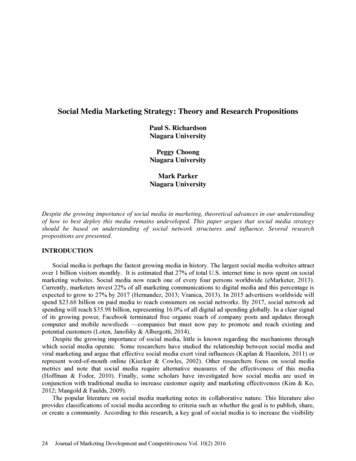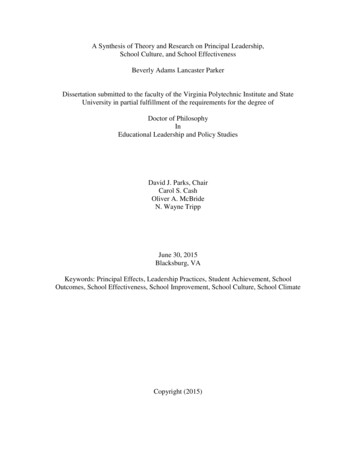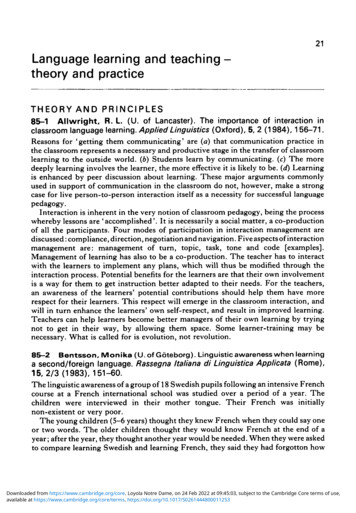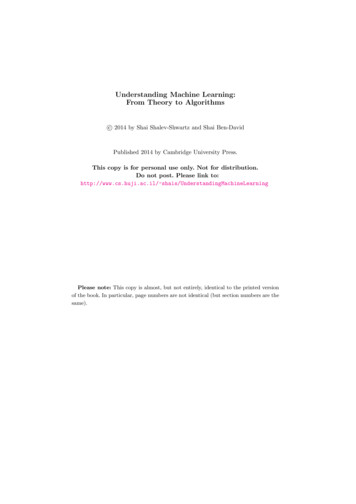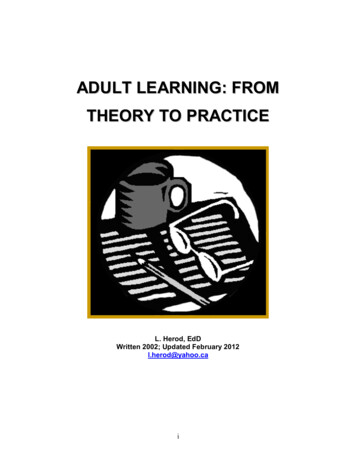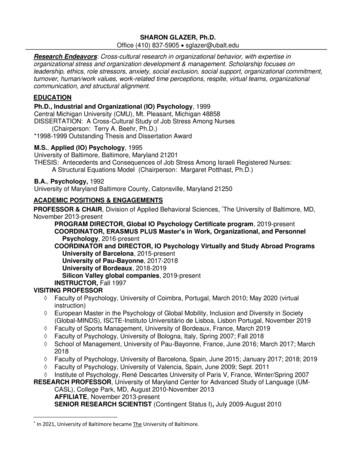
Transcription
Learning: Theory and ResearchLearning theory and research have long been the province of education and psychology, but what is now known about howpeople learn comes from research in many different disciplines. This chapter of the Teaching Guide introduces three centrallearning theories, as well as relevant research from the fields of neuroscience, anthropology, cognitive science, psychology, andeducation.In This SectionOverview of Learning TheoriesBehaviorismCognitive ConstructivismSocial ConstructivismNeuroscience and How Students LearnCognitive Science: Memory and LearningAnthropology: Situated Learning in Communities of PracticePsychology: Motivation and LearningEducation: Organizing the Learning ProcessEducation: Learning to Think in a DisciplineGSI Teaching & Resource Centergsi@berkeley.edu510-642-4456301 Sproul HallOffice Hours 9–12, 1–4Graduate Division, UC Berkeley 2016 UC RegentsGraduate Student Instructor Teaching & Resource Center, Graduate Division, UC Berkeley 2016 Regents of the University of California1
Overview of Learning TheoriesAlthough there are many different approaches to learning, there are three basic types of learning theory: behaviorist, cognitiveconstructivist, and social constructivist. This section provides a brief introduction to each type of learning theory. The theories aretreated in four parts: a short historical introduction, a discussion of the view of knowledge presupposed by the theory, an accountof how the theory treats learning and student motivation, and finally, an overview of some of the instructional methods promotedby the theory is presented.BehaviorismCognitive ConstructivismSocial ConstructivismView of knowledge Knowledge is a repertoire ofbehavioral responses toenvironmental stimuli.Knowledge systems of cognitivestructures are actively constructedby learners based on pre-existingcognitive structures.Knowledge is constructed withinsocial contexts through interactionswith a knowledge community.View of learningActive assimilation andaccommodation of new informationto existing cognitive structures.Discovery by learners.Integration of students into aknowledge community.Collaborative assimilation andaccommodation of newinformation.View of motivation Extrinsic, involving positive andnegative reinforcement.Intrinsic; learners set their owngoals and motivate themselves tolearn.Intrinsic and extrinsic. Learninggoals and motives are determinedboth by learners and extrinsicrewards provided by the knowledgecommunity.Implications forTeachingThe teacher facilitates learning byproviding an environment thatpromotes discovery andassimilation/accommodation.Collaborative learning is facilitatedand guided by the teacher. Groupwork.Passive absorption of a predefinedbody of knowledge by the learner.Promoted by repetition and positivereinforcement.Correct behavioral responses aretransmitted by the teacher andabsorbed by the students.GSI Teaching & Resource Centergsi@berkeley.edu510-642-4456301 Sproul HallOffice Hours 9–12, 1–4Graduate Division, UC Berkeley 2016 UC RegentsGraduate Student Instructor Teaching & Resource Center, Graduate Division, UC Berkeley 2016 Regents of the University of California2
BehaviorismBehaviorist teaching methods have proven most successful in areas where there is a"correct" response or easily memorized material.BackgroundView of KnowledgeView of LearningView of MotivationImplications for TeachingBackgroundMethodological behaviorism began as a reaction against the introspective psychology that dominated the late 19thand early 20th centuries. Introspective psychologists such as Wilhelm Wundt maintained that the study ofconsciousness was the primary object of psychology. Their methodology was primarily introspective, relying heavily onfirst-person reports of sensations and the constituents of immediate experiences. Behaviorists such as J. B. Watsonand B. F. Skinner rejected introspectionist methods as being subjective and unquantifiable. Instead, they focused onobjectively observable, quantifiable events and behavior. They argued that since it is not possible to observeobjectively or to quantify what occurs in the mind, scientific theories should take into account only observableindicators such as stimulus-response sequences. According to Skinner (1976, 23),The mentalistic problem can be avoided by going directly to the prior physical causes while bypassing intermediatefeelings or states of mind. The quickest way to do this is to . consider only those facts which can be objectivelyobserved in the behavior of one person in its relation to his [or her] prior environmental history.Radical behaviorists such as Skinner also made the ontological claim that facts about mental states are reducible tofacts about behavioral dispositions.View of KnowledgeBehaviorists such as Watson and Skinner construe knowledge as a repertoire of behaviors. Skinner argues that it is notthe case that we use knowledge to guide our action; rather "knowledge is action, or at least rules for action" (152). It isa set of passive, largely mechanical responses to environmental stimuli. So, for instance, the behaviorist would arguethat to say that that someone knows Shakespeare is to say that they have a certain behavioral repertoire with respectto Shakespeare (152). Knowledge that is not actively expressed in behavior can be explained as behavioral capacities.For example, "I know a bluebird when I see one" can be seen as effectively equivalent to "I have the capacity toidentify a bluebird although I am not now doing so" (154). If knowledge is construed as a repertoire of behaviors,someone can be said to understand something if they possess the appropriate repertoire. No mention of cognitiveprocesses is necessary (156-57).View of LearningFrom a behaviorist perspective, the transmission of information from teacher to learner is essentially the transmissionof the response appropriate to a certain stimulus. Thus, the point of education is to present the student with theappropriate repertoire of behavioral responses to specific stimuli and to reinforce those responses through aneffective reinforcement schedule (161). An effective reinforcement schedule requires consistent repetition of thematerial; small, progressive sequences of tasks; and continuous positive reinforcement. Without positivereinforcement, learned responses will quickly become extinct. This is because learners will continue to modify theirGraduate Student Instructor Teaching & Resource Center, Graduate Division, UC Berkeley 2016 Regents of the University of California3
behavior until they receive some positive reinforcement.View of MotivationBehaviorists explain motivation in terms of schedules of positive and negative reinforcement. Just as receiving foodpellets each time it pecks at a button teaches a pigeon to peck the button, pleasant experiences cause humanlearners to make the desired connections between specific stimuli and the appropriate responses. For example, astudent who receives verbal praise and good grades for correct answers (positive reinforcement) is likely to learnthose answers effectively; one who receives little or no positive feedback for the same answers (negativereinforcement) is less likely to learn them as effectively. Likewise, human learners tend to avoid responses that areassociated with punishment or unpleasant consequences such as poor grades or adverse feedback.Implications for TeachingBehaviorist teaching methods tend to rely on so-called "skill and drill" exercises to provide the consistent repetitionnecessary for effective reinforcement of response patterns. Other methods include question (stimulus) and answer(response) frameworks in which questions are of gradually increasing difficulty; guided practice; and regular reviews ofmaterial. Behaviorist methods also typically rely heavily on the use of positive reinforcements such as verbal praise,good grades, and prizes. Behaviorists assess the degree of learning using methods that measure observable behaviorsuch as exam performance. Behaviorist teaching methods have proven most successful in areas where there is a"correct" response or easily memorized material. For example, while behaviorist methods have proven to besuccessful in teaching structured material such as facts and formulae, scientific concepts, and foreign languagevocabulary, their efficacy in teaching comprehension, composition, and analytical abilities is questionable.ReferenceSkinner, B. F. (1976). About Behaviorism. New York: Vintage Books.GSI Teaching & Resource Centergsi@berkeley.edu510-642-4456301 Sproul HallOffice Hours 9–12, 1–4Graduate Division, UC Berkeley 2016 UC RegentsGraduate Student Instructor Teaching & Resource Center, Graduate Division, UC Berkeley 2016 Regents of the University of California4
Cognitive ConstructivismCognitivist teaching methods aim to assist students in assimilating new information toexisting knowledge, and enabling them to make the appropriate modifications to theirexisting intellectual framework to accommodate that information.BackgroundView of KnowledgeView of LearningView of MotivationImplications for TeachingJean PiagetWilliam G. PerryReferencesBackgroundDissatisfaction with behaviorism's strict focus on observable behavior led educational psychologists such as JeanPiaget and William Perry to demand an approach to learning theory that paid more attention to what went on "insidethe learner's head." They developed a cognitive approach that focused on mental processes rather than observablebehavior. Common to most cognitivist approaches is the idea that knowledge comprises symbolic mentalrepresentations, such as propositions and images, together with a mechanism that operates on thoserepresentations. Knowledge is seen as something that is actively constructed by learners based on their existingcognitive structures. Therefore, learning is relative to their stage of cognitive development; understanding thelearner's existing intellectual framework is central to understanding the learning process.View of KnowledgeWhile behaviorists maintain that knowledge is a passively absorbed behavioral repertoire, cognitive constructivistsargue instead that knowledge is actively constructed by learners and that any account of knowledge makes essentialreferences to cognitive structures. Knowledge comprises active systems of intentional mental representations derivedfrom past learning experiences. Each learner interprets experiences and information in the light of their extantknowledge, their stage of cognitive development, their cultural background, their personal history, and so forth.Learners use these factors to organize their experience and to select and transform new information. Knowledge istherefore actively constructed by the learner rather than passively absorbed; it is essentially dependent on thestandpoint from which the learner approaches it.View of LearningBecause knowledge is actively constructed, learning is presented as a process of active discovery. The role of theinstructor is not to drill knowledge into students through consistent repetition, or to goad them into learning throughcarefully employed rewards and punishments. Rather, the role of the teacher is to facilitate discovery by providing thenecessary resources and by guiding learners as they attempt to assimilate new knowledge to old and to modify the oldto accommodate the new. Teachers must thus take into account the knowledge that the learner currently possesseswhen deciding how to construct the curriculum and to present, sequence, and structure new material.View of MotivationGraduate Student Instructor Teaching & Resource Center, Graduate Division, UC Berkeley 2016 Regents of the University of California5
Unlike behaviorist learning theory, where learners are thought to be motivated by extrinsic factors such as rewardsand punishment, cognitive learning theory sees motivation as largely intrinsic. Because it involves significantrestructuring of existing cognitive structures, successful learning requires a major personal investment on the part ofthe learner (Perry 1999, 54). Learners must face up to the limitations of their existing knowledge and accept the needto modify or abandon existing beliefs. Without some kind of internal drive on the part of the learner to do so, externalrewards and punishments such as grades are unlikely to be sufficient.Implications for TeachingCognitivist teaching methods aim to assist students in assimilating new information to existing knowledge, andenabling them to make the appropriate modifications to their existing intellectual framework to accommodate thatinformation. Thus, while cognitivists allow for the use of "skill and drill" exercises in the memorization of facts, formulae,and lists, they place greater importance on strategies that help students to actively assimilate and accommodate newmaterial. For instance, asking students to explain new material in their own words can assist them in assimilating it byforcing them to re-express the new ideas in their existing vocabulary. Likewise, providing students with sets ofquestions to structure their reading makes it easier for them to relate it to previous material by highlighting certainparts and to accommodate the new material by providing a clear organizational structure. Because learning is largelyself-motivated in the cognitivist framework, cognitivists such as A. L. Brown and J. D. Ferrara have also suggestedmethods which require students to monitor their own learning. For instance, the use of ungraded tests and studyquestions enables students to monitor their own understanding of the material. Other methods that have beensuggested include the use of learning journals by students to monitor progress and highlight any recurring difficulties,and to analyze study habits.Jean PiagetThe most influential exponent of cognitivism was Swiss child psychologist Jean Piaget. Piaget rejected the idea thatlearning was the passive assimilation of given knowledge. Instead, he proposed that learning is a dynamic processcomprising successive stages of adaption to reality during which learners actively construct knowledge by creating andtesting their own theories of the world (1968, 8). Piaget’s theory has two main strands: first, an account of themechanisms by which cognitive development takes place; and second, an account of the four main stages of cognitivedevelopment through which children pass.The basic principle underlying Piaget's theory is the principle of equilibration: all cognitive development (including bothintellectual and affective development) progresses towards increasingly complex and stable levels of organization.Equilibration takes place through a process of adaption, that is, assimilation of new information to existing cognitivestructures and the accommodation of that information through the formation of new cognitive structures. Forexample, learners who already have the cognitive structures necessary to solve percentage problems in mathematicswill have some of the structures necessary to solve time-rate-distance problems, but they will need to modify theirexisting structures to accommodate the newly acquired information to solve the new type of problem. Thus, learnersadapt and develop by assimilating and accommodating new information into existing cognitive structures.Piaget suggested that there are four main stages in the cognitive development of children. In the first two years,children pass through a sensorimotor stage during which they progress from cognitive structures dominated byinstinctual drives and undifferentiated emotions to more organized systems of concrete concepts, differentiatedemotions, and their first external affective fixations. At this stage, children's outlook is essentially egocentric in thesense that they are unable to take into account others' points of view. The second stage of development lasts untilaround seven years of age. Children begin to use language to make sense of reality. They learn to classify objects usingdifferent criteria and to manipulate numbers. Children's increasing linguistic skills open the way for greatersocialization of action and communication with others. From the ages of seven to twelve years, children begin todevelop logic, although they can only perform logical operations on concrete objects and events. In adolescence,children enter the formal operational stage, which continues throughout the rest of their lives. Children develop theability to perform abstract intellectual operations, and reach affective and intellectual maturity. They learn how toformulate and test abstract hypotheses without referring to concrete objects. Most importantly, children develop thecapacity to appreciate others' points of view as well as their own.Piaget's theory was widely accepted from the 1950s until the 1970s. Although the theory is not now as widelyaccepted, it has had a significant influence on later theories of cognitive development. For instance, the idea ofGraduate Student Instructor Teaching & Resource Center, Graduate Division, UC Berkeley 2016 Regents of the University of California6
adaption through assimilation and accommodation is still widely accepted.William G. PerryWilliam G. Perry, an educational researcher at Harvard University, developed an account of the cognitive andintellectual development of college-age students through a fifteen-year study of students at Harvard and Radcliffe inthe 1950s and 1960s. Perry generalized that study to give a more detailed account of post-adolescent developmentthan did Piaget. He also introduces the concept of positionality and develops a less static view of developmentaltransitions.The sequence of cognitive structures that make up the developmental process may be described in terms of crosssections of cognitive structures representative of different stages in the developmental sequence. Each stage isconstrued as a relatively stable, enduring cognitive structure, which includes and builds upon past structures. Stagesare characterized by the coherence and consistency of the structures that compose them. The transition betweenstages is mediated by less stable, less consistent transitional structures. Freud, Whitehead, and Piaget all use thenotion of a stage in this way. Perry rejects the notion of a stage. He argues that construing development in terms of asequence of stable stages in which students are "imprisoned" is too static (Perry 1999, xii). Instead, he introduces thenotion of a position. Perry accepted Piaget's claim that learners adapt and develop by assimilating and accommodatingnew information into existing cognitive structures. He also accepted Piaget's claim that the sequence of cognitivestructures that constitute the developmental process are both logically and hierarchically related, insofar as eachbuilds upon and thus presupposes the previous structure. However, he laid far greater emphasis on the idea thatlearners approach knowledge from a variety of different standpoints. Thus, according to Perry, gender, race, culture,and socioeconomic class influence our approach to learning just as much as our stage of cognitive development (xii).We each interpret the world from a different position (46) and each person may occupy several positionssimultaneously with respect to different subjects and experiences (xii). The developmental process is a constantlychanging series of transitions between various positions.Perry provides the following illustration different types of position (1999, 2):. a lecturer announces that today he will consider three theories explanatory of .Student A has always taken it for granted that knowledge consists of correct answers, that there is one right answer per problem,and that teachers explain these answers for students to learn. He therefore listens for the lecturer to state which theory to learn.Student B makes the same general assumptions but with an elaboration to the effect that teachers sometimes present problemsand procedures, rather than answers, "so that we can learn to find the right answer on our own."Student C assumes that an answer can be called "right" only in the light of its context, and that contexts or "frames of reference"differ .Whatever the lecturer then proceeds to do., these three students will make meaning of the experience in different ways whichwill involve different assessments of their own choices and responsibilities.Perry identifies nine basic positions, of which the three major positions are duality, multiplicity, and commitment.The most basic position is duality. The world, knowledge and morality are assumed to have a dualistic structure.Things are right or wrong, true or false, good or bad. Students see teachers as authority figures who impart rightanswers and "the truth." The role of the student is seen as being to receive those answers and demonstrate thatthey have learned them. Detachment is difficult in this because there is only a single, correct point of view. Moststudents have passed beyond this stage by the time that they arrive in university. Those who have not quickly do soin the inherently pluralistic culture of modern universities.Positions two through four are largely transitional. Learners gradually develop an increased recognition ofmultiplicity but still assimilate that multiplicity to the fundamentally dualistic framework of the first position. Forinstance, a student may recognize the existence of a multiplicity of different points of view in the university but stilllook for the point of view that the teacher "wants us to learn" (121).The next major position is multiplicity. The world, knowledge and morality are accepted as relativistic in the sensethat truth is seen as relative to a frame of reference rather than absolute. Learners recognize that things can only besaid to be right or wrong within a specific context. Teachers are seen as expert guides or consultants rather than asauthority figures who impart "the truth." Peers are accepted as legitimate sources of learning (xxxii). This positioninvolves a much more extensive restructuring of the learner's existing knowledge than previous positions asknowledge can no longer be assimilated to the existing dualistic organizational scheme.Graduate Student Instructor Teaching & Resource Center, Graduate Division, UC Berkeley 2016 Regents of the University of California7
Positions six through eight are also largely transitional. Recognition of the relativity of knowledge leads to therealization that a stable locus or point of view is necessary for a sense of identity and to give some feeling ofcontinuity. This leads to the gradual formation of commitments to certain points of view, relationships, sorts ofactivities, etc. The learner realizes the necessity to find his own point of view in a relativistic world. He or she beginsby questioning and reconsidering past beliefs and commitments, then develops and expands upon firmcommitments regarding important areas of life and knowledge.The final major position is commitment. The commitments that the learners have developed together with theirrecognition that all knowledge is relative, leads to the realization both that each person partly determines his or herown fate and the recognition that commitments, and hence identity, are constantly evolving.Because Perry's initial research was based on a small and fairly non-representative sample of students, many of thedetails of his positions have been modified or developed by later researchers. However, the idea of positionality hashad a significant influence on social identity theory and his account of developmental transitions is consonant withcurrent approaches to adult learning (xii).ReferencesPerry, William G. (1999). Forms of Ethical and Intellectual Development in the College Years. San Francisco: Jossey-BassPublishers.Piaget, Jean (1968). Six Psychological Studies. Anita Tenzer (Trans.), New York: Vintage Books.GSI Teaching & Resource Centergsi@berkeley.edu510-642-4456301 Sproul HallOffice Hours 9–12, 1–4Graduate Division, UC Berkeley 2016 UC RegentsGraduate Student Instructor Teaching & Resource Center, Graduate Division, UC Berkeley 2016 Regents of the University of California8
Social ConstructivismThe level of potential development is the level at which learning takes place. It comprisescognitive structures that are still in the process of maturing, but which can only matureunder the guidance of or in collaboration with others.BackgroundView of KnowledgeView of LearningView of MotivationImplications for TeachingReferenceBackgroundSocial constructivism is a variety of cognitive constructivism that emphasizes the collaborative nature of much learning.Social constructivism was developed by post-revolutionary Soviet psychologist Lev Vygotsky. Vygotsky was a cognitivist,but rejected the assumption made by cognitivists such as Piaget and Perry that it was possible to separate learningfrom its social context. He argued that all cognitive functions originate in, and must therefore be explained as productsof social interactions and that learning was not simply the assimilation and accommodation of new knowledge bylearners; it was the process by which learners were integrated into a knowledge community. According to Vygotsky(1978, 57),Every function in the child's cultural development appears twice: first, on the social level and, later on, on the individual level; first,between people (interpsychological) and then inside the child (intrapsychological). This applies equally to voluntary attention, to logicalmemory, and to the formation of concepts. All the higher functions originate as actual relationships between individuals.Vygotsky'stheory of social learning has been expanded upon by numerous later theorists and researchers.View of KnowledgeCognitivists such as Piaget and Perry see knowledge as actively constructed by learners in response to interactionswith environmental stimuli. Vygotsky emphasized the role of language and culture in cognitive development. Accordingto Vygotsky, language and culture play essential roles both in human intellectual development and in how humansperceive the world. Humans' linguistic abilities enable them to overcome the natural limitations of their perceptual fieldby imposing culturally defined sense and meaning on the world. Language and culture are the frameworks throughwhich humans experience, communicate, and understand reality. Vygotsky states (1968, 39),A special feature of human perception . is the perception of real objects . I do not see the world simply in color and shape but also asa world with sense and meaning. I do not merely see something round and black with two hands; I see a clock .Language and the conceptual schemes that are transmitted by means of language are essentially social phenomena.As a result, human cognitive structures are, Vygotsky believed, essentially socially constructed. Knowledge is not simplyconstructed, it is co-constructed.View of LearningVygotsky accepted Piaget's claim that learners respond not to external stimuli but to their interpretation of thosestimuli. However, he argued that cognitivists such as Piaget had overlooked the essentially social nature of language.As a result, he claimed they had failed to understand that learning is a collaborative process. Vygotsky distinguishedbetween two developmental levels (85):Graduate Student Instructor Teaching & Resource Center, Graduate Division, UC Berkeley 2016 Regents of the University of California9
The level of actual development is the level of development that the learner has already reached, and is the level at which the learner iscapable of solving problems independently. The level of potential development (the "zone of proximal development") is the level ofdevelopment that the learner is capable of reaching under the guidance of teachers or in collaboration with peers. The learner iscapable of solving problems and understanding material at this level that they are not capable of solving or understanding at their levelof actual development; the level of potential development is the level at which learning takes place. It comprises cognitive structures thatare still in the process of maturing, but which can only mature under the guidance of or in collaboration with others.View of MotivationBehavioral motivation is essentially extrinsic -- a reaction to positive and negative reinforcements. Cognitive motivationis essentially intrinsic -- based on the learner's internal drive. Social constructivists see motivation as both extrinsic andintrinsic. Because learning is essentially a social phenomenon, learners are partially motivated by rewards provided bythe knowledge community. However, because knowledge is actively constructed by the learner, learning also dependsto a significant extent on the learner's internal drive to understand and promote the learning process.Implications for TeachingCollaborative learning methods require learners to develop teamwork skills and to see individual learning as essentiallyrelated to the success of group learning. The optimal size for group learning is four or five people. Since the averagesection size is ten to fifteen people, collaborative learning methods often require GSIs to break students into smallergroups, although discussion sections are essentially collaborative learning environments. For instance, in groupinvestigations, students may be split into groups that are then required to choose and research a topic from a limitedarea. They are then held responsible for researching the topic and presenting their findings to the class. Moregenerally, collaborative learning should be seen as a process of peer interaction that is mediated and structured bythe teacher. Discussion can be promoted by the presentation of specific concepts, problems, or scenarios; i
Social Constructivism Neuroscience and How Students Learn Cognitive Science: Memory and Learning . work. GSI Teaching & Resource Center gsi@berkeley.edu 510-642-4456 301 Sproul Hall Office Hours 9–12, 1–4 . such as exam performance. Behaviorist teaching meth



